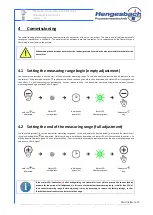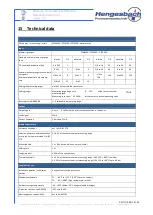
Pressure Transmitters 050D series
Operating Instructions
- English - V1.0
PN-TI118-EN-14-1/15
Hengesbach GmbH & Co. KG
·
Schimmelbuschstr. 17
·
40699 Erkrath
·
Tel. +49 (0) 21 04 / 30 32-0
·
Fax +49 (0) 21 04 / 30 32-22
·
www.hengesbach.com
10
Servicing and cleaning
The transmitter does not contain any parts that can be serviced by the user. Should the device not perform as expected, first read the
troubleshooting and rectification section in chapter 14. Should anything remain unclear, contact the manufacturer in order to determine
the next step.
Any changes that are made to the inside of the device will automatically result in the loss of warranty.
Furthermore, the manufacturer reserves the right to reject any repair request for devices, which have been
opened by the customer. This does not apply to the opening of the device lid for the purpose of wiring or
parametrisation.
You should only check the electrical connections, seals and pressure compensation openings (only for relative pressure devices) as part of
your regular service activities.
Make sure that the connection wires are tightly secured in the screw terminals and the cable screw connections are tightly connected to
the connection wire (if applicable). For devices with an M12 plug, the screw connection must be checked for a tight fit. Also check the tight
fit of the lid in order to ensure the best possible sealing.
The ventilation opening must be free from highly viscose media or other adhesive media. A blocked ventilation opening prevents the
pressure compensation of relative pressure devices and will result in the distortion of the measuring value. If the reference cable is used,
the ventilation tube must also be free from foreign objects.
The transmitters are fully encapsuled and therefore have no dead spaces. However, especially during the cleaning process, major heating-
up with subsequent cooling-down processes can result in a vacuum inside the device. This effect will be reduced to a minimum due to the
small dead space volume. However, the transmitter head should be visually inspected at regular intervals in order to make sure that no
foreign media have ingressed. Such foreign media can result in the build-up of conductive deposits (salts, etc.), which cause leakage
currents, which will distort the measuring result.
You should also check the seals, both in the lid and at the process connection, for corrosion.
Observe the maximum permitted temperatures when cleaning. Sustained overtemperature can destroy both the
electronics and attachments at the housing.
The membrane of the measuring cell may not be directly radiated by localised pressure sources, such as high-
pressure cleaning equipment. This may result in the destruction of the membrane. Continue to avoid any other
form of mechanical contact with the sensor membrane.
11
Storage and operating conditions
The device is intended for operation / storage in a temperature range of -40°C to +85°C. These specifications do not apply to the medium
temperature - depending on the process connection used, this can deviate from the maximum permissible operation thresholds. Read the
corresponding entries on the transmitter data sheet (see section 15: Technical Data).
Operation or storage outside the permissible temperature range can result in malfunction and irreversible
damage to the device. Observe the permissible thresholds for the medium temperature





































